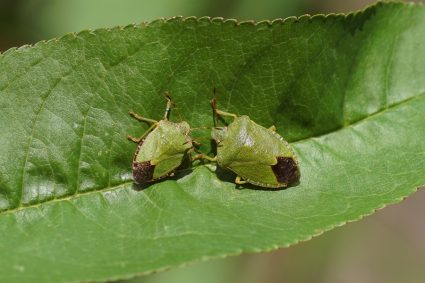
Japanese beetles are notorious pests that can wreak havoc on your garden, feeding on more than 300 species of plants. The damage they cause is unmistakable: skeletonized leaves and flowers, often leaving only the veins behind. If you’ve ever experienced a Japanese beetle invasion, you know just how destructive these pests can be. However, with the right knowledge and strategies, you can keep these pests at bay. In this comprehensive guide, we’ll explore how to keep Japanese beetles away from your garden and home.
To keep Japanese beetles away, maintain a healthy landscape, use repellent sprays, attract natural enemies, plant deterrents, apply preventive grub insecticides, and monitor susceptible plants. If an infestation occurs, use eco-friendly control methods such as hand-picking, insecticidal soap, neem oil, milky spore, and cedar oil spray. Additionally, harness natural predators like birds and insects to help control the beetle population. Regular monitoring and timely intervention are key to minimize damage.
Identifying Japanese Beetles
Before you can effectively deal with Japanese beetles, it’s important to know what you’re looking for. Adult Japanese beetles are about 1/2 inch in length with an oval-shaped body. They have a metallic-green head and thorax, contrasting with their metallic-bronze or copper-brown wing covers. A distinguishing feature is the six pairs of white hair tufts along each side of their abdomen, with two additional tufts at the tip.
Recognizing an Infestation
Typical signs of a Japanese beetle infestation include seeing adult beetles, plant damage, flying beetles, brown patches on the lawn, and an increased presence of predators like birds and skunks. Japanese beetles feed on the plant fiber of leaves, resulting in lacy-looking, skeletonized leaves with only the veins remaining. Trees with severe infestations may have a scorched appearance.
Preventative Measures
There are several proactive steps you can take to prevent a Japanese beetle infestation:
- Maintain a healthy landscape: Remove diseased and poorly nourished trees, as well as any other potential breeding sites.
- Use repellent sprays: Spray your plants with a smell that repels Japanese beetles, such as raw neem oil.
- Attract natural enemies: Encourage the presence of beneficial insects like ladybugs, lacewings, and birds that feed on beetles and their larvae.
- Plant deterrents: Grow plants that repel or harm Japanese beetles, such as geraniums (which paralyze them when ingested) or companion plants like catnip, garlic, and marigold.
- Apply preventive grub insecticides: Use products containing imidacloprid, halofenzide, clothianidin, or thiamethoxam to target the grub stage of Japanese beetles.
- Use beneficial nematodes and milky spore: Apply beneficial nematodes in spring before the beetles emerge and use milky spore to kill grubs in the soil.
- Monitor susceptible plants: Keep an eye on plants that are most attractive to Japanese beetles, such as roses, birch, linden, grapes, raspberries, and Norway maples.
- Use Japanese beetle traps wisely: Set up traps far away from your garden and only use them for a day or two at a time every couple of weeks.
Remember, prevention is always better than cure. By taking these steps, you can make your garden less inviting to Japanese beetles and reduce the chance of an infestation.
Eco-friendly and Non-toxic Control Methods
If you already have an infestation, there are several eco-friendly and non-toxic methods to control Japanese beetles:
- Hand-picking: Remove beetles from plants by hand and drop them into a bucket of soapy water to kill them. This is most effective in the morning when the beetles are less active.
- Insecticidal soap: Spray a mixture of mild liquid soap and water directly on the beetles. It kills some on contact and makes the rest easier to hand-pick.
- Neem oil: Spray affected plants with neem oil, which acts as an antifeedant and reduces feeding by the beetles.
- Milky Spore: This naturally occurring bacterium can be used to control grubs in the soil.
- Cultural methods: Plant resistant plant species, use mechanical traps, and manage irrigation regimes to reduce beetle numbers.
- Cedar oil spray: Cedar oil is an effective repellent against Japanese beetles. It won’t kill them, but they will avoid areas treated with cedar oil.
- Biological control: Some parasites, nematodes, and fungi can be used to control Japanese beetle populations.
Harnessing Natural Predators
Nature has its own way of controlling pests, and Japanese beetles are no exception. Tachinid flies, birds, insects, spiders, and mammals all prey on Japanese beetles, helping to control their population. While these natural predators may not be able to eliminate the beetles entirely or as quickly as the beetles can damage crops and plants, they can help manage the population when combined with other control methods.
In conclusion, Japanese beetles can be a significant nuisance, but with the right strategies, you can keep them away from your garden and home. By combining preventative measures, eco-friendly control methods, and the use of natural predators, you can protect your plants from these destructive pests. Remember, the key is regular monitoring and timely intervention to minimize the damage caused by these pests.
Frequently Asked Questions
What time of the year are Japanese beetles most active?
Japanese beetles are most active during the warm months of summer, typically from late June through August or September, depending on the region.
How long does a Japanese beetle live?
The adult Japanese beetle lives for approximately 30 to 45 days.
Are Japanese beetles harmful to humans or pets?
No, Japanese beetles are not harmful to humans or pets. They are a nuisance because of the damage they cause to plants and crops, but they do not pose a direct threat to humans or animals.
What are the most common plants that Japanese beetles are attracted to?
Japanese beetles are known to feed on over 300 species of plants, but some of their favorites include roses, grapes, linden trees, birch trees, raspberries, and Norway maples.
Can Japanese beetle traps attract more beetles to my garden?
Yes, Japanese beetle traps can inadvertently attract more beetles to your property. This is why it’s recommended to place traps far away from your garden and only use them for a day or two at a time every couple of weeks.
How often should I apply neem oil or other repellent sprays?
The frequency of application can depend on the severity of your beetle problem and the specific product you’re using, but generally, repellent sprays like neem oil can be applied once every 1-2 weeks during the peak beetle season. Always read and follow the instructions on the product label.











